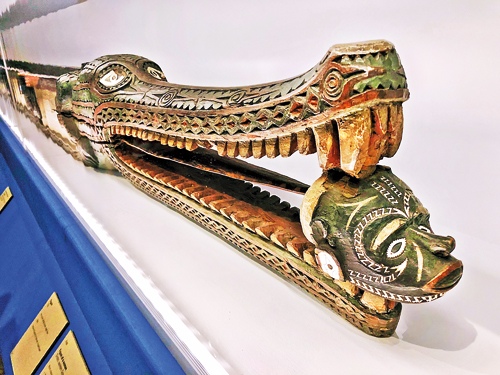An educative voyage through the history of Pacific Islands

Part of islander life: Everyday objects, all intricately carved
I must confess, going into this exhibition I knew very little about the Pacific Islands. Maybe that was part of the reason I was so keen to see the exotically titled ‘Oceania’ exhibition before I left London, following a work trip. Before this, my only (rather ignorant) impressions of the Pacific Islands were a set of little nations strewn across the Pacific Ocean, fairly inconspicuous and inconsequential to the rest of that region, and populated by hefty men who ride canoes in the sea and hunt fish, and formidable women who all looked like ‘Moana’ from the popular Disney movie. I couldn’t possibly have imagined the rich heritage that I was about to be treated to over the next two hours that I spent at the Royal Academy of Arts (RAA). I was truly blown away.
The exhibition, hosted by the RAA and sponsored by the Governments of New Zealand, Papua New Guinea, and the Kingdom of Tonga, skilfully took visitors on a voyage through art, history, and visual encounter across the region of ‘Oceania’. Oceania or Oceanie, as coined by French geographer Conrad Malte-Brun, is an area that covers roughly a third of the world’s surface and comprises countless islands and archipelagos. Influenced by their encounters through voyage and trade, artistic originality has flourished in the Pacific Islands stimulating. I was immediately impressed by the intricacy of their carvings– whether it was the huge sturdy canoes or the captivating god statues. Their elaborate clothes and ceremonial headdresses were made using an eclectic range of natural materials – from the skin of the puffer fish to ceramic stones, shark teeth and dog hair to the feathers of birds ‘who fly the highest in the sky’.
Notably, their art and sculptures are not just for art’s sake but are integral to their existence – life, livelihood, war, faith; to show strength, and to honour their ancestors and gods (‘tiki’). Even the canoes and paddles taken for daily use are adorned with incredibly intricate,and sometimes menacing, motifs. Through this, the Pacific Islanders aimed at projecting strength, and striking fear in the minds of potential rivals. There were, apparently, frequent inter-tribe and inter-island wars.
The exhibition brought together close to 200 works from public collections worldwide, spanning over 500 years. It was so well curated that, while showcasing this richness of heritage of ‘Oceania’, it does not shy away from, or attempt to whitewash, the impact of colonization.In particular through the audio narratives and interviews that accompany a visitor’s journey through the exhibition, there was a conscious effort to interrogate the questions around colonisation. In the issue around the collection of these artifacts, what I found revealing was that the Pacific Islanders had agency. From the first voyage of Captain James Cook in 1768, artifacts and cultural items were collected by European explorers, but not ‘looted by the colonizers’ as one would have a tendency to think. Most were gifted, trafficked, or exchanged willingly by the people of Tahiti, Tonga, PNG, and others who also wanted in return what the Europeans had to offer. They traded or exchanged it for items not just from Europe but items that the Europeans would bring from other faraway islands in Oceania, resulting in a very interesting mixing of art influences and inspiration across these islands.
Of course, some exhibits were controversial because they showed things that belong now exclusively to museums in the UK and in Europe. There is a tension here because some of the people of those countries want these artifacts returned home, while others have a great sense of pride in showcasing them to the world and want them to stay on display to serve as emissaries for their cultures.
I hadn’t realized until this exhibition the sheer number of islands (and indeed countries) that make up the Pacific Islands – beyond the ones you and I are most familiar with – like Samoa or PNG.Following Cook’s first voyage some 120 years ago, Europeans began to claim sovereignty over the area and with little regard for the rich and distinct cultural histories of the Islands, they crudely and divided Oceania into three regions and gave them rather unimaginative names – Micronesia (literally, ‘small islands’), Melanesia (‘black islands’), and Polynesia (‘many islands’). The present-day names of these islands range from the familiar ones like Tuvalu and Tonga, to not so familiar ones like Wallis and Fortuna, Nauru, Marquesas, and Norfolk Island. Sadly, though, much of the smaller islands’ populations were decimated by sexually transmitted diseases brought across by the European explorers.
I was intrigued by the complexity of their navigation techniques – drawing rather elaborate navigation maps not on paper, but using an deliberate arrangement of sticks woven together with thread. These maps were so complex in that they not just showed routes, but depicted a network of highways on the high seas and showed where sea swells and currents arose(using bends in the sticks). Over time, these maps became an encyclopedia of navigation for that whole area and would serve generations of ocean-going Pacific Islanders.
In summary, this exhibition was incredibly rewarding for me, as an islander in a neighbouring ocean. I was moved by how the Pacific Islanders had responded to both the challenges and opportunities offered by European colonization – going from confrontation and depopulation, to the exchange of materials and ideas. My concluding thoughts as I left the Royal Academy that day was how cleverly the curators of this exhibition had collaborated with Islander communities and artists, respectfully showcased their rich cultural heritage, grappled with the tensions around colonial collections, and managed to engage and educate visitors, many of whom would have hitherto been uninitiated in the cultures of Oceania.


